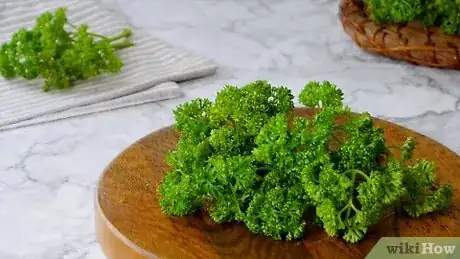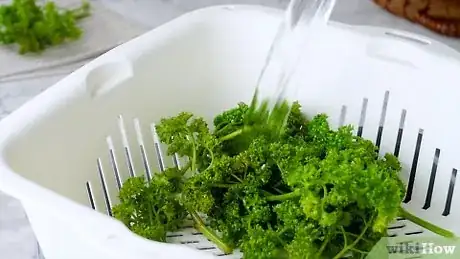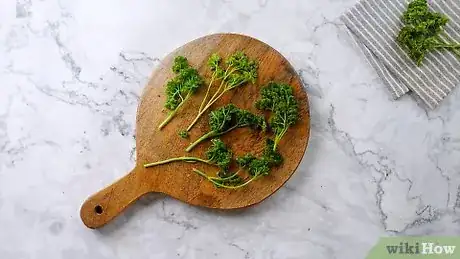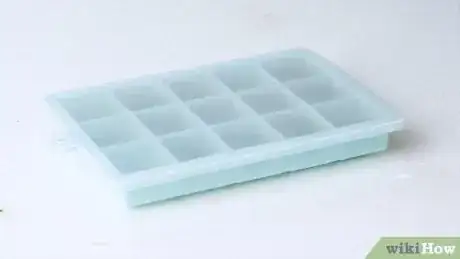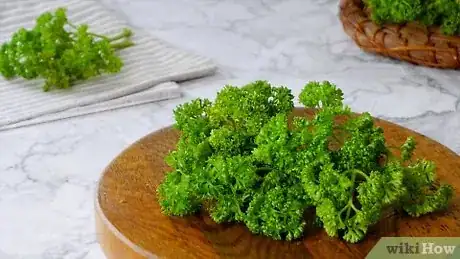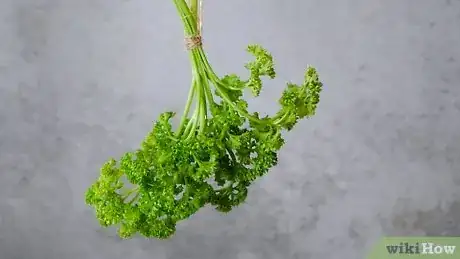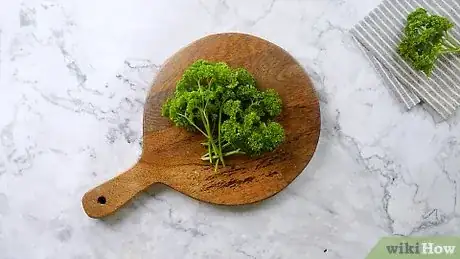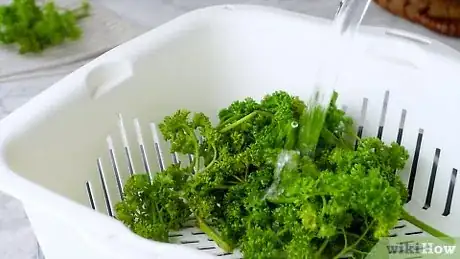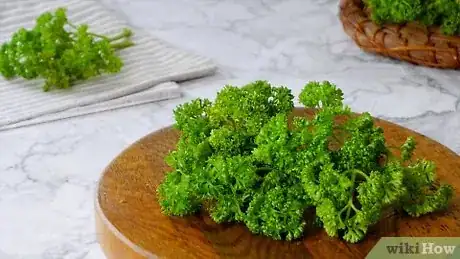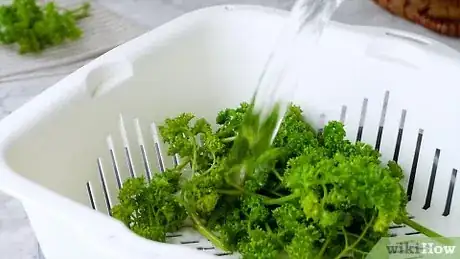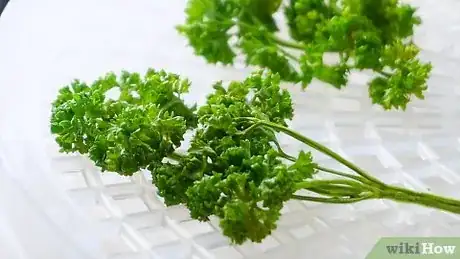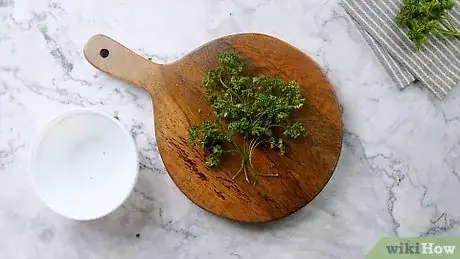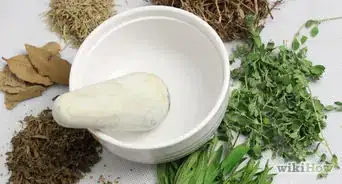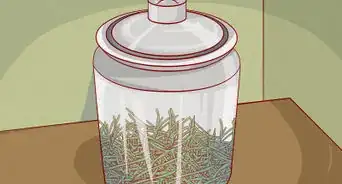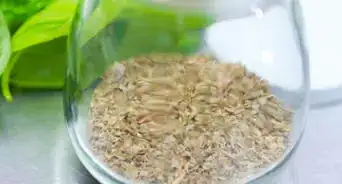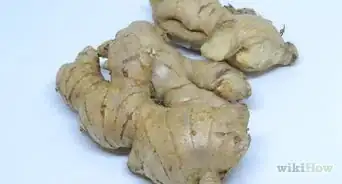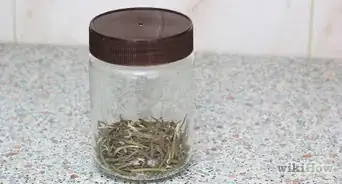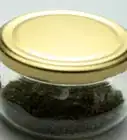wikiHow is a “wiki,” similar to Wikipedia, which means that many of our articles are co-written by multiple authors. To create this article, volunteer authors worked to edit and improve it over time.
The wikiHow Culinary Team also followed the article's instructions and verified that they work.
This article has been viewed 53,613 times.
Learn more...
Parsley is a versatile herb that tastes best when it is fresh, but it can also be preserved for later use. It is commonly used in French and Italian cuisine, and can be used in a range of dishes, including fish, chicken, pasta, and vegetables. It also can be used as a garnish or tea or to aid digestion and bladder issues, and is high in vitamin K, vitamin C, and folic acid.[1] Some have even reported brewing strong parsley tea to use as a hair rinse to get rid of head lice.
Steps
Refrigerating Parsley
-
1Harvest fresh parsley from your garden. Gather parsley before the first flowers start to open, and gather it in the morning after the dew has dried. It will have maximum flavor at this time of day; the heat of the afternoon will diminish the parsley's flavor. Alternately, purchase fresh parsley at a grocery store. Choose bright green bunches of parsley that look nice and smell fresh. Don't pick parsley that is shriveled, brown, moldy, or is dried out. Carefully cut the parsley with stems still attached, and be careful to not bruise the leaves.
-
2Rinse the parsley. Use cold water to rinse, and then shake the parsley gently to remove excess water from the leaves. This will remove any residual dirt, as well as any bugs that crawled into your parsley.Advertisement
-
3Chop parsley into small pieces and discard stems. Alternatively, leave the parsley sprigs whole.
-
4Place parsley pieces on a plate or tray and store in refrigerator. Place the parsley on the top shelf, keeping it away from any foods that might drip on the parsley.
-
5Gently toss the parsley every day. Tossing the parsley will ensure that it will dry evenly on all sides. Within 2-3 days, the parsley should be dry and will retain its bright green color.
- If you dry entire stems of parsley, drying time might take up to a week.[2]
-
6Transfer the dried parsley to an airtight container. Store it in a cool, dry place.
Blanching and Freezing Parsley
-
1Harvest fresh parsley from your garden. Gather parsley before the first flowers start to open, and gather it in the morning after the dew has dried. It will have maximum flavor at this time of day; the heat of the afternoon will diminish the parsley's flavor. Alternately, purchase fresh parsley at a grocery store. Choose bright green bunches of parsley that look nice and smell fresh. Don't pick parsley that is shriveled, brown, moldy, or is dried out. Carefully cut the parsley with stems still attached, and be careful to not bruise the leaves.
-
2Rinse the parsley. Use cold water to rinse, and then shake the parsley gently to remove excess water from the leaves. This will remove any residual dirt, as well as any bugs that crawled into your parsley.
-
3Blanch the parsley in boiling water. Blanching is a method that scalds herbs, vegetables or fruit so that their color and flavor will last when they are preserved.[3] To blanch the parsley, use tongs to dip sprigs of parsley into a pot of boiling water briefly and swirl them around. Pull out the parsley when the color brightens.
- The blanching step can be skipped, but the parsley will likely have less flavor and may have a gray-green color.
-
4Cool the parsley by either running it under cold water or letting it cool in the air. This will stop the parsley from cooking after being in contact with boiling water.
-
5Remove stems and finely chop parsley with a knife.
-
6Pack chopped parsley into an ice cube tray and add a little water into each ice cube compartment. Be careful not to overflow the ice cube tray with water. Alternatively, put the chopped parsley in small freezer bags.
-
7Freeze the parsley ice cubes for about 24 hours or until they are solidly frozen.
-
8Store the parsley ice cubes in a freezer bag or airtight freezer-safe container. Use within 4-6 months. [4]
Air Drying Parsley
-
1Harvest fresh parsley from your garden. Gather parsley before the first flowers start to open, and gather it in the morning after the dew has dried. It will have maximum flavor at this time of day; the heat of the afternoon will diminish the parsley's flavor. Alternately, purchase fresh parsley at a grocery store. Choose bright green bunches of parsley that look nice and smell fresh. Don't pick parsley that is shriveled, brown, moldy, or is dried out. Carefully cut the parsley with stems still attached, and be careful to not bruise the leaves.
-
2Rinse the parsley. Use cold water to rinse, and then shake the parsley gently to remove excess water from the leaves. This will remove any residual dirt, as well as any bugs that crawled into your parsley.
-
3Tie stems of parsley together with string into bundles. Wrap a paper bag around each bundle of parsley to keep dust and sunshine from the parsley while it is drying. Sunshine can diminish the drying parsley’s bright green color. If you wrap the bundles with paper bags, be sure to allow enough air flow around each bundle so that they do not mold. Check each bundle occasionally to ensure there is no mold growth.
-
4Hang these bundles either indoors or outdoors. Indoor drying will typically produce more flavorful dried herbs. This process may take a week or two to produce fully dried parsley. If you hang the bundles outdoors, be sure to choose a spot that is protected from moisture, animals and birds. Tie the bundles securely so that they do not blow away.
-
5Store your parsley. When leaves are crumbly, they are ready to put into an airtight container and stored in a cool, dry place.
Oven Drying Parsley
-
1Harvest fresh parsley from your garden. Gather parsley before the first flowers start to open, and gather it in the morning after the dew has dried. It will have maximum flavor at this time of day; the heat of the afternoon will diminish the parsley's flavor. Alternately, purchase fresh parsley at a grocery store. Choose bright green bunches of parsley that look nice and smell fresh. Don't pick parsley that is shriveled, brown, moldy, or is dried out. Carefully cut the parsley with stems still attached, and be careful to not bruise the leaves.
-
2Rinse the parsley. Use cold water to rinse, and then shake gently to remove excess water from the leaves. This will remove any residual dirt, as well as any bugs that crawled into your parsley.
-
3Line a cookie sheet with parchment paper and spread the parsley leaves on the sheet. If the parsley has contact with the metal cookie sheet, it can darken the parsley's color.
-
4Set your oven to its lowest heat setting and place the cookie sheet of parsley in the oven on the top rack. This will ensure adequate air-flow around the cookie sheet while the parsley is drying.
-
5Check on the parsley periodically to ensure that it is not burning. It should dry within 2-4 hours.
-
6Store the dried parsley in an airtight container. Keep it in a cool, dry place.
Using a Dehydrator to Dry Parsley
-
1Harvest fresh parsley from your garden. Gather parsley before the first flowers start to open, and gather it in the morning after the dew has dried. It will have maximum flavor at this time of day; the heat of the afternoon will diminish the parsley's flavor. Alternately, purchase fresh parsley at a grocery store. Choose bright green bunches of parsley that look nice and smell fresh. Don't pick parsley that is shriveled, brown, moldy, or is dried out. Carefully cut the parsley with stems still attached, and be careful to not bruise the leaves.
-
2Rinse the parsley. Use cold water to rinse, and then shake the parsley gently to remove excess water from the leaves. This will remove any residual dirt, as well as any bugs that crawled into your parsley.
-
3Preheat the dehydrator to between 95–115 °F (35–46 °C). If you are in a location with high humidity, you may need to raise the temperature to 125 °F (52 °C).
-
4Spread parsley evenly on a tray. Leave space around each sprig, and place the tray in the dehydrator. This will ensure that air in the dehydrator will circulate around the parsley evenly.
-
5Keep an eye on your parsley. Monitor the parsley periodically, and remove it when it is dry. If the leaves crumble and the stems break instead of bend, then the parsley is dry.
- It can take anywhere from one to four hours to fully dehydrate the parsley, depending on your machine.
-
6Store the dried parsley in an airtight container. Keep it in a cool, dry place.[5]
Using a Microwave to Dry Parsley
-
1Harvest fresh parsley from your garden. Gather parsley before the first flowers start to open, and gather it in the morning after the dew has dried. It will have maximum flavor at this time of day; the heat of the afternoon will diminish the parsley's flavor. Alternately, purchase fresh parsley at a grocery store. Choose bright green bunches of parsley that look nice and smell fresh. Don't pick parsley that is shriveled, brown, moldy, or is dried out. Carefully cut the parsley with stems still attached, and be careful to not bruise the leaves.
-
2Rinse the parsley. Use cold water to rinse, and then shake the parsley gently to remove excess water from the leaves. This will remove any residual dirt, as well as any bugs that crawled into your parsley.
-
3Cover the parsley with paper towels. Place a paper towel on a plate and place a single layer of parsley leaves on it. Then cover the leaves with another paper towel.
-
4Microwave the leaves for 30 seconds. Watch them constantly to ensure that they do not burn. If the parsley is not fully dry, gently toss the parsley leaves to ensure it is drying evenly. Microwave the leaves for another 30 seconds.
- Times may vary depending on the model of your microwave. Follow the instructions for your microwave.
-
5Store the dried parsley in an airtight container in a cool, dry place.
-
6Finished.
Community Q&A
-
QuestionHow do I use fresh parsley?
 Joy SongCommunity AnswerYou can make a dish with shrimp and cashew nuts. Here is the recipes. 1. Rinse and dry the shrimp. Then marinate them with a little cooking wine, white pepper powder and a little salt for 20 minutes. 2. Wash the parsley and cut into small pieces. 3. Heat some oil and saute some diced ginger. 4. Stir fry the shrimp first and then remove them. 5. Stir fry celery until medium-well cooked, re-add the shrimp, then season with salt and chicken powder. Add the cooked cashew nuts and serve.
Joy SongCommunity AnswerYou can make a dish with shrimp and cashew nuts. Here is the recipes. 1. Rinse and dry the shrimp. Then marinate them with a little cooking wine, white pepper powder and a little salt for 20 minutes. 2. Wash the parsley and cut into small pieces. 3. Heat some oil and saute some diced ginger. 4. Stir fry the shrimp first and then remove them. 5. Stir fry celery until medium-well cooked, re-add the shrimp, then season with salt and chicken powder. Add the cooked cashew nuts and serve.
References
- ↑ http://www.whfoods.com/genpage.php?tname=foodspice&dbid=100
- ↑ http://www.motherearthliving.com/cooking-methods/dry-your-herbs-in-the-fridge.aspx#axzz3F1PcRSmi
- ↑ http://www.extension.umn.edu/food/food-safety/preserving/vegetables-herbs/blanching-vegetables/
- ↑ http://www.four-h.purdue.edu/foods/Freezing%20fresh%20herbs.htm
- ↑ http://nchfp.uga.edu/how/dry/herbs.html
About This Article
To preserve fresh parsley in the refrigerator, either leave the parsley whole or chop it into small pieces and discard any stems. Place the parsley on a plate or a tray and store it on the top shelf of your refrigerator. Gently toss the parsley once a day for 2-3 days or until it is completely dry, then transfer the dried parsley to an airtight container and store it in a cool, dry place. If you prefer to air dry your parsley, tie it into bundles and hang them in a cool dry place for 1-2 weeks. If you want to learn how to blanch and freeze your parsley, keep reading the article!
